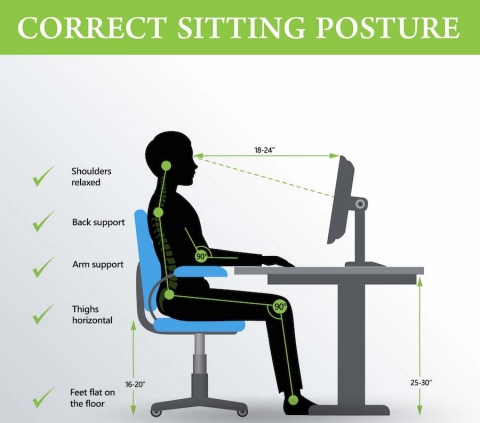When we think of workplace injuries, most of us probably picture a construction site rather than an office. But OSHA reports that musculoskeletal disorders (MSDs) account for more than $15 billion in workers’ compensation costs every year. And those are “just” from sitting at a desk and working on a computer, and don’t include trips, falls and other common office accidents.
According to WebMD.com, the most common MSDs are caused by repetitive stress and include:
- Carpal tunnel syndrome: A condition that causes numbness, tingling and other symptoms in the hand and arm. Carpal tunnel syndrome is caused by a compressed nerve in the carpal tunnel, a narrow passageway on the palm side of your wrist.
Read: Carpal Tunnel Syndrome: The Good, The Bad and the Ugly.
- Muscle strains: These strains affect the neck, upper back, lower back, and shoulders.
- Tendon injuries: The result of gradual wear and tear to the tendon from overuse or aging, these injuries usually cause pain, stiffness and loss of strength in the affected area.
- Bursitis: This condition is a result of inflammation or irritation of the bursa — a sac filled with lubricating fluid — which is located between bones, muscles, tendons and skin and decreases rubbing, friction and irritation.
Fortunately, many of these injuries can be prevented through ergonomics, which is the science of designing the job to fit the worker, rather than physically forcing the worker’s body to fit the job.

Ergonomics 101
The easiest way to understand ergonomics is with the number 90, as in a 90-degree angle. That’s where you want to position your legs, arms, back, etc. to avoid injuries commonly associated with office work.
“When you’re sitting at a desk, you want your shoulders back and your head in good alignment,” says GBO Occupational Therapist Cindy Hartman. She says it all starts with your hips. “Make sure they’re at a good 90-degree angle and then work up and down from there.”
For most of us, this will require some adjustment. Here are just a few tips Cindy shares to make working at a 90-degree angle easier to accomplish:
- Position your feet flat on the floor or on a footrest, so your thighs are parallel to the floor.
- Adjust your chair’s backrest to fit the inward curve of your back.
- Place your keyboard, top of the mouse and writing surfaces near elbow height.
- Keep wrists straight while typing and using your mouse.
- Set the top of your computer display at or below eye level and position it directly in front of you (not to the side), 20 to 40 inches from your eyes.
- Note: Laptops should not be used as primary computers. When using your laptop at work, use a docking station with an adjustable keyboard to help keep your wrists in a neutral position.
- Note: Laptops should not be used as primary computers. When using your laptop at work, use a docking station with an adjustable keyboard to help keep your wrists in a neutral position.
- Use an external mouse instead of the laptop’s touchpad.
- Place frequently used items close at hand. Stand to pick up things that are beyond an easy reach from your seated position.
- Make motions such as typing and stapling with the least amount of force possible.
- Clear items out from under your desk so you have legroom.
Though there is a huge business in ergonomic supplies, Cindy says none of this has to cost much money. “Books are great for lifting your monitor or keyboard to the right angle,” she says. “If you have books around you, you can accomplish most of this.”
Just move
In addition to arranging your body and your work environment, you’ll want to do something that doesn’t cost any money at all — get up and move.
Cindy recommends taking micro-breaks throughout the day. “People need to stretch and change positions frequently,” she says. “And they should stand up and walk around at least once every hour.”
“It’s all about efficiency of your body, so you’re working smarter not harder,” she says. “When you’re just sitting there in one position for an extended period of time, your muscles are co-contracting. You have to move throughout the day to give your muscles a variety of tasks to do.”
Your body might remind you that it’s time to stand up, but by then it could be too late. Instead, set a timer to remind yourself to do this simple task.
“Typing breaks can be used for other things so you’re still being productive,” Cindy says. “But it’s important to reduce the strain associated with sitting in one position all day. And movement helps your blood flow, which is also good for your muscles.”
If you think you might be suffering from an MSD or repetitive stress injury, give us a call at 775-786-1600. Cindy and the other therapists in Great Basin Orthopaedics’ new Physical Therapy department might be just what you need to set your body right.